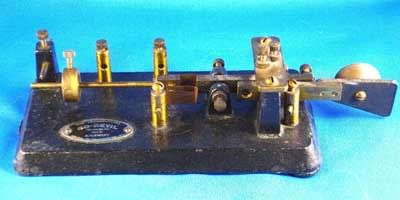It's been a big ham radio weekend here on the hill!

For starters, I wound up filling several pages in my log operating the Kentucky QSO Party. I found a clear spot on 40 and held a pile-up — believe it or not — for about an hour. I haven't done any real contesting of late, so this was a lot of fun, truly some casual contesting at its best. The party format is nice, it runs one day, not a two-day, 24-hour marathon.
I also ran across stations working the SKCC WES (Weekend Sprint). The SKCC (Straight Key Century Club) has a couple of operating events each month, including the WES. The SKCC offers awards for making contacts with other SKCC members, so the operating events are excellent ways to meet other members and earn their awards.
I had my three newest bugs on the operating system, and my new Bencher RJ-1. I spent most of the time actually working with the 1958 Vibroplex Original DeLuxe; I had to adjust it and clean the contacts; with that done, it played very well.
But the weekend also had some exciting moments on eBay as auctions for some really nice keys came to a close.
Shown at right is the Eddystone semi-automatic key. The Eddystone is the only bug every built in Great Britain. Fewer than 400 built between 1948 and 1952. The bug is unique because of its cover; the inner workings are very similar to the Vibroplex Champion mechanism.
According to my research, 250 were built in 1948, followed by a second order for 250 in 1949. Of the second batch, only about 100 were sold; the remaining were purchased by radio dealer who sold them from his shop.
The key looks to be in good condition; you seldom see these keys for sale on eBay, so I watched this one with great interest. I don't know why, but there wasn't a lot of interest in this key; I won the auction for quite a bit less than I anticipated.
 Another key I chased this evening was the Go Devil bug pictured at right. This is another key that rarely shows up for sale on eBay. I chased this one to just about the top limit of my “sniping” on this auction; the truth is that I really wanted it.
Another key I chased this evening was the Go Devil bug pictured at right. This is another key that rarely shows up for sale on eBay. I chased this one to just about the top limit of my “sniping” on this auction; the truth is that I really wanted it.
There are a number of less common and rare semi-automatic keys that represent the “next level” of key collecting, and the Go Devil, made in the 1930s, is in that category.
There were actually two different models made nearly 20 years apart. A second model Go Devil was made in the 1950s; neither version of the key saw much success.
Another interesting key I sniped at what I felt was a low price was a Brown Brothers iambic/straight key double key model CTL-A.
This double key combo was made in 1974, and it features the newer leaf spring-based iambic key and the pivoting straight key. Brown Brothers keys command rather steep prices, particularly the older BTL iambic paddle that uses the traditional pivot/coil spring levers.
Enough eBay madness this trip … more to come!
